Solutions to Midterm Examination
Solutions to Midterm Examination
Solutions to Midterm Examination
You also want an ePaper? Increase the reach of your titles
YUMPU automatically turns print PDFs into web optimized ePapers that Google loves.
Prof. Li-Yan Yuan<br />
CMPUT 291: File and Database Management Systems<br />
<strong>Solutions</strong> <strong>to</strong> <strong>Midterm</strong> <strong>Examination</strong><br />
Section B1, February 24, 2004<br />
1. Construct an E-R diagram for a car-insurance company that has a set of cus<strong>to</strong>mers, each of<br />
whom owns one or more cars. Each car has associated with it zero <strong>to</strong> any number of recorded<br />
accidents. The company also maintains the statistical information for each type of vehicle,<br />
such as the accident and car theft ratio.<br />
If you have any doubt about the specification, make a reasonable assumption. Document all<br />
your assumptions. Please use the textbook notations <strong>to</strong> specify the mapping constraints. [18]<br />
2. The following ER diagram characterizes information about an on-line book s<strong>to</strong>re. Cus<strong>to</strong>mer,<br />
S<strong>to</strong>re, Book s<strong>to</strong>re information about cus<strong>to</strong>mers, s<strong>to</strong>res, and books respectively. Order represents<br />
each order placed by a cus<strong>to</strong>mer. Relationship set supply indicates which s<strong>to</strong>re supplies<br />
which book <strong>to</strong> which order; and ordered indicates who placed the order.<br />
Cus<strong>to</strong>mer<br />
S<strong>to</strong>re<br />
✻<br />
❅<br />
ordered<br />
❅<br />
❅❅<br />
❅<br />
✗<br />
Date<br />
✖<br />
✔<br />
✕<br />
❅<br />
supply<br />
❅<br />
❅❅<br />
❅<br />
✲<br />
Order<br />
Book<br />
The attributes for all entity sets are Cus<strong>to</strong>mer(c id, c name, c address), Order(o id, o data),<br />
S<strong>to</strong>re(s id, s address), Book(isbn, title, price), with c id, o id, s id, isbn as respective<br />
keys. Note that the arrow indicates the one side of the corresponding relationship set.<br />
Use the SQL’s CREATE TABLE statement <strong>to</strong> create the database schema from the ER<br />
diagram, specifying all the essential constraints. State any reasonable assumptions you may<br />
have. [12]<br />
CREATE TABLE s<strong>to</strong>re (<br />
s_id int,<br />
s_address VARCHAR(200),<br />
PRIMARY KEY (s_id)<br />
)<br />
1
CREATE TABLE book (<br />
isbn VARCHAR(24),<br />
title VARCHAR(48),<br />
price NUMERIC(10,2),<br />
PRIMARY KEY (isbn)<br />
)<br />
CREATE TABLE cus<strong>to</strong>mer (<br />
c_id int,<br />
c_name VARCHAR(128),<br />
c_address VARCHAR(200),<br />
PRIMARY KEY (c_id)<br />
)<br />
CREATE TABLE order (<br />
o_id int,<br />
o_data VARCHAR(500),<br />
c_id int,<br />
o_date DATE,<br />
PRIMARY KEY (o_id),<br />
FOREIGN KEY c_id REFERENCES cus<strong>to</strong>mer<br />
)<br />
CREATE TABLE supply (<br />
s_id int,<br />
isbn VARCHAR(24),<br />
o_id int,<br />
PRIMARY KEY ( s_id, isbn, o_id),<br />
FOREIGH KEY s_id REFERENCES s<strong>to</strong>re,<br />
FOREIGN KEY isbn REFERENCES book,<br />
FOREIGH KEY o_id REFERENCES order<br />
)<br />
3. Consider a university registration database with the following tables.<br />
student(s id, s name, status, phone, major)<br />
professor(p id, p name, dept)<br />
teach(p id, c id, term)<br />
transcript(s id, c id, term, grade)<br />
The first two tables s<strong>to</strong>re information about students and professors; the third table indicates<br />
who teaches which course at which term; and the last table s<strong>to</strong>res information about course<br />
registration.<br />
Use SQL <strong>to</strong> express the following queries. (You results may contain duplicate tuples.)<br />
2
(a) Find the names (s name) of all students who have taken a course taught by a professor<br />
in the ’CS’ department.<br />
SELECT s_name<br />
FROM student s, transcript t, teach c, professor p<br />
WHERE s.s_id = t.s_id AND t.c_id = c.c_id AND<br />
c.p_id = p.p_id AND p.dept = ’CS’ AND<br />
t.term = c.term<br />
(b) Find the names of all students who have taken more than one course taught by a professor<br />
from the ’CS’ department. You cannot not use aggregate functions with or without the<br />
group by clause for this question.<br />
SELECT s_name<br />
FROM student s, transcript t1, transcript t2, teach c1, teach c2,<br />
professor p1, professor p2<br />
WHERE s.s_id = t1.s_id AND t1.c_id = c1.c_id AND t1.term = c1.term AND<br />
c1.p_id = p1.p_id AND p1.dept = ’CS’ AND<br />
s.s_id = t2.s_id AND t2.c_id = c2.c_id AND t2.term = c2.term AND<br />
c2.p_id = p2.p_id AND p2.dept = ’CS’ AND<br />
(t1.c_id t2.c_id OR t1.term t2.term)<br />
(c) List the names of all students who have taken a course from every professor in the<br />
’MUSIC’ department.<br />
SELECT s_name<br />
FROM student s, transcript t, teach c, professor p<br />
WHERE s.s_id = t.s_id AND t.c_id = c.c_id AND t.term = c.term AND<br />
c.p_id = p.p_id AND p.dept = ’MUSIC’<br />
GROUP BY s_name<br />
HAVING COUNT( DISTINCT p_id) >= ANY ( SELECT count(*)<br />
FROPM professor<br />
WHERE dept = ’MUSIC’<br />
)<br />
SELECT s_name<br />
FROM student s<br />
WHERE NOT EXIST ( SELECT *<br />
FROM professor p<br />
WHERE p.dept = ’MUSIC’ AND<br />
NOT EXIST ( SELECT *<br />
FROM transacript t, teach c<br />
WHERE s.s_id = t.s_id AND<br />
t.c_id = c.c_id AND<br />
p.c_id = c.c_id AND<br />
3
)<br />
)<br />
t.term = c.term<br />
(d) List the names of students whose average grade is higher than that of all junior students.<br />
A junior student is a student whose status is ’junior’.<br />
SELECT s_name<br />
FROM student s, transcript t<br />
WHERE s.s_id = t.s_id<br />
GROUP BY s_name, s.s_id<br />
HAVING AVG(grade) > ALL ( SELECT AVG(grade)<br />
FROM student s2, transacript t2<br />
WHERE s2.s_id = t2.s_id AND s2.status = ’junior’<br />
GROUP BY s2.s_id<br />
)<br />
(e) List the course id and the average grade taught by each professor in the ’CS’ department<br />
in the ’winter03’ term. That is, you are asked <strong>to</strong> list p id, c id, and the average grade<br />
for each course c id taught by p id in ’winter03’ term.<br />
SELECT p.p_id, c.c_id, AVG(t.grade)<br />
FROM teach c, transcript t, professor p<br />
WHERE c.c_id = t.c_id AND c.p_id = p.p_id AND p.dept = ’CS’ AND<br />
c.term = ’winter03’<br />
GROUP BY p.p_id, c.c_id<br />
(f) List p id and p name of all professors who have never taught a course taken by a junior<br />
student.<br />
SELECT p_id, p_name<br />
FROM professor<br />
EXCEPT<br />
SELECT p.p_id, p.p_name<br />
FROM professor p, teach c, transacript t, student s<br />
WHERE p.p_id = c.p_id AND c.c_id = t.c_id AND c.term = t.term AND<br />
t.s_id = s.s_id AND s.status = ’junior’<br />
(g) Assume that a major always coincides with a department name. list, for each department,<br />
the number of professors who are working for the department, the number of<br />
students who major in the department, and the number of courses taught by professors<br />
from the department.<br />
Note that a course taught in two different terms is counted as one, not two, course taught<br />
by the department.<br />
SELECT p.dept, count(distinct p.p_id), count(distinct s.s_id),<br />
count(distinct c.c_id)<br />
4
FROM professor p, teach c, student s<br />
WHERE p.dept = s.major AND p.p_id = c.p_id<br />
GROUP BY p.dept<br />
4. Consider a relational database about a university with the following three relations<br />
teach(Prof, Course)<br />
take(Student, Course, Grade)<br />
advise (Prof, Student)<br />
The first relation indicates the courses a prof teaches; the second tells what courses each<br />
student takes and the corresponding grades; and the last indicates advisers of a student.<br />
Write a relational algebra expression <strong>to</strong> retrieve<br />
(a) all students who do not take a course from their own advisers.<br />
Π Student (take) − Π Student (teach ✶ take ✶ advise)<br />
(b) A <strong>to</strong>ugh course is a course in which no one receives a grade higher than ’6’. List the<br />
names of all students who take only <strong>to</strong>ugh courses. [14]<br />
Π Student (take) − Π Student1 (σ C1=C2∧G2>6 (take[S1, C1, G] × take[S2, C2, G2]))<br />
Or, alternatively,<br />
Π Student (take)−Π take1.Student (σ take1.Course=take2.Course∧take2.Course.grade>6 (take1×take2))<br />
Note that both take1 and take2 are take.<br />
5




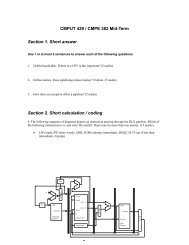

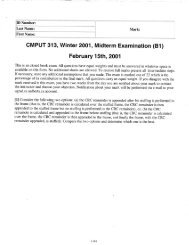
![CMPUT 313 Final Exam [Harms] April 26, 2000 g L (Ilosed Book](https://img.yumpu.com/45617471/1/190x245/cmput-313-final-exam-harms-april-26-2000-g-l-ilosed-book.jpg?quality=85)
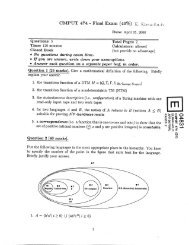
![CMPUT 379 Midterm Exam [Harms]](https://img.yumpu.com/44750568/1/190x245/cmput-379-midterm-exam-harms.jpg?quality=85)



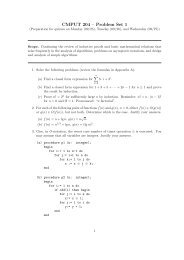

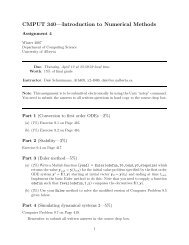
![CMPUT 272 Midterm [B2 -- Harms]](https://img.yumpu.com/36401258/1/190x245/cmput-272-midterm-b2-harms.jpg?quality=85)